

Fast Feedback. Our first Magic Monday kicked off at lunchtime with a “Pedagogy Picnic”.

I drew the short straw had the honour of kicking things off first, with a 7 minute presentation on “Fast Feedback“. Here’s a summary of my presentation. The impact of feedback in raising attainment has been well documented by academics such as Dylan Wiliam, John Hattie and more recently by the Sutton Trust Education Endowment Foundation in their Toolkit findings. Written feedback can be a time consuming task though and the purpose of this presentation was to try to pull together a variety of methods that could speed up feedback, without compromising the quality of it. I wanted to share a range of strategies, rather than focus in more detail on a few. Dylan Wiliam has said that feedback should be more work for the recipient than the donor. The provision of quality success criteria are key to effective assessment. Verbal feedback is another powerful technique we can use prior to giving written feedback.
#5MinPlan series. Www.eriding.net/resources/english/ks3/060101_jlodge_eng_ks3_how_am_I_doing.pdf. 10 ways to use QR Codes in your history classroom. I’m sure you’ve seen them.

They are showing up everywhere. QR codes. Those little, square squiggly barcode looking things. A QR code is a handy way to share all sorts of information quickly and easily – the QR part actually stands for Quick Response. QR codes are designed to be de-coded by dedicated QR readers and smartphone apps. And I know you’re asking yourself So what? I know . . . cause early on, I was saying the same thing. Especially as more and more of our students are carrying around smartphones and other mobile devices like iPads and iPods, the use of QR codes can be incredibly powerful.
Kids can learn when and where they want. So I started looking around for ways to integrate the use of QR codes into history instruction. 10 ways to use QR Codes in a History classroom. Kerry ⋅ EdTech, History ⋅ History, QR Code ⋅ 14 comments Photo by DavidPitkin This post comes with a huge acknowledgement to several people in my PLN – who, through constant tweeting about QR Codes, have forced me to take a look at their worth.
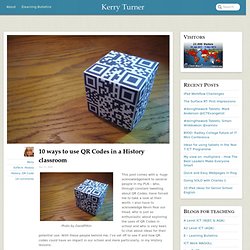
Formative assessment techniques feedback. WHSGeography: Student Assessment- Directed... The perfect ofsted_lesson_-_article. Marking is an act of love. Have you ever flicked back through an exercise book and seen the same repeated comments followed with soul numbing certainty by the same repeated mistakes?
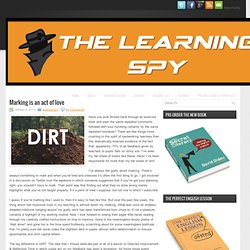
There are few things more crushing to the spirit of hardworking teachers than this dramatically enacted evidence of the fact that, apparently, 70% of all feedback given by teachers to pupils falls on stony soil. Marking Matters. Like most teachers in the autumn term, I have set myself a few targets, some of them to do with marking.
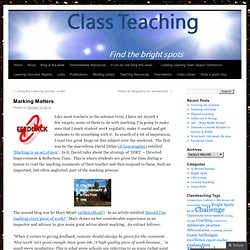
I’m going to make sure that I mark student work regularly, make it useful and get students to do something with it. In search of a bit of inspiration, I read two great blogs on this subject over the weekend. The first was by the marvellous David Didau (@LearningSpy) entitled ‘Marking is an act of love’. In it, David talks about the strategy of ‘DIRT’ – Directed Improvement & Reflection Time. This is where students are given the time during a lesson to read the marking comments of their teacher and then respond to them. The second blog was by Mary Myatt (@MaryMyatt). “When it comes to giving feedback, reasons should always be given for the comment. Marking Matters. Reduce-workload.jpg (1611×2320) Making Feedback Count: “Close the Gap” Recently I have been looking again at the issue of marking.
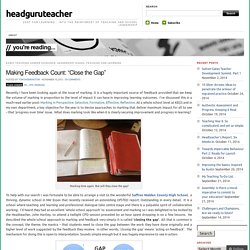
Marking in Perspective: Selective, Formative, Effective, Reflective. Marking in Perspective: Selective, Formative, Effective, Reflective Context and Motivation I’m feeling relieved, smug and virtuous because I’ve just marked some books.
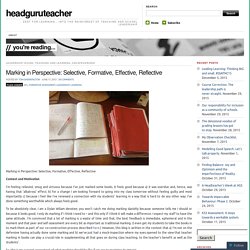
APP Geography Grids. APP Geography. De-based marking. Collaborative research for assessment for learning. Abstract This paper reports on a collaborative research study between three secondary teachers and two university researchers, initiated by the teachers, into the practice and impacts of assessment for learning in science, geography and history classes.

The research provides insights into how teachers and researchers can collaborate to develop a research and practice agenda. The study illustrates the need for a dynamic interconnection between the personal, micro or school-related level and the macro or policy level factors. The findings highlight the importance of external support, shared teacher knowledge and beliefs, professional experimentation, and shared reflection on student responses to classroom innovations. Keywords Assessment for learning; Collaborative research; Secondary school; Policy Copyright © 2009 Elsevier Ltd.
Lazy Marking in Geography. Its not an original thought I know, but I HATE marking.
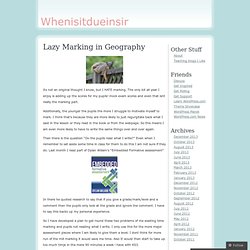
The only bit all year I enjoy is adding up the scores for my pupils’ mock exam scores and even that isnt really the marking part. Additionally, the younger the pupils the more I struggle to motivate myself to mark. I think that’s because they are more likely to just regurgitate back what I said in the lesson or they read in the book or from the webpage.